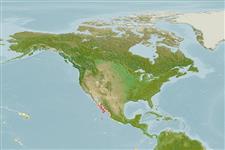Klassifizierung / Names
Namen | Synonyme | Catalog of Fishes(Gattung, Arten) | ITIS | CoL | WoRMS | Cloffa
>
Blenniiformes (Blennies) >
Chaenopsidae (Pike-, tube- and flagblennies)
Etymology: Acanthemblemaria: Greek, akantha = thorn + Greek, emblema, -atos, anything that is nailed, knocked in; also anything with bass or high relief (Ref. 45335); hastingsi: Named for Philip A. Hastings.
Eponymy: Dr Philip Alan ‘Phil’ Hastings (d: 1951) is Professor of Marine Biology at Scripps Institution of Oceanography, University of California, San Diego and Curator of Marine Vertebrates. [...] (Ref. 128868), visit book page.
Environment: milieu / climate zone / Tiefenbereich / distribution range
Ökologie
seewasser demersal; tiefenbereich 1 - 3 m (Ref. 84469). Tropical
Eastern Pacific: Gulf of California (limited to Mulegé to Cabo San Lucas along the Baja Peninsula and between Isla San Pedro Nolasco and Isla San Ignacio de Farallon along the Mexican continental mainland, Ref. 26771).
Size / Gewicht / Alter
Geschlechtsreife: Lm ? range ? - ? cm
Max length : 5.1 cm SL Männchen/unbestimmt; (Ref. 84469); 4.0 cm SL (female)
Kurzbeschreibung
Bestimmungsschlüssel | Morphologie | Morphometrie
Rückenflossenstacheln (insgesamt) : 23 - 25; Rückenflossenweichstrahlen (insgesamt) : 12 - 14; Afterflossenstacheln: 2; Wirbelzahl: 42 - 44. This species is distinguished from its congeners in the Pacific, excluding its closest relatives, A. macrospilus and A. mangognatha, by having a single row of large brown blotches along its lateral midline and head spines that are pointed (vs. club-like or ridge-like). It differs from the 2 latter species by having a dark swath of melanophores on the dorsal fin in both males and females that highlights the bright orange coloration on that fin; presence of scattered melanophores reaching the tip of the lower jaw; and expression of orange as the primary bright head color. This species is further distinguishable from A. macrospilus by the 71 fixed mutations in COI and 20 fixed mutations in the D-loop region of its mitochondrial genome (Ref, 84469).
Body shape (shape guide): elongated.
Life cycle and mating behavior
Geschlechtsreife | Fortpflanzung | Ablaichen | Eier | Fecundity | Larven
Lin, H.-C. and G.R. Galland, 2010. Molecular analysis of Acanthemblemaria macrospilus (Teleostei: Chaenopsidae) with descriptions of a new species from the Gulf of California, Mexico. Zootaxa 2525:51-62. (Ref. 84469)
IUCN Rote Liste Status (Ref. 130435: Version 2025-1)
Bedrohung für Menschen
Harmless
Nutzung durch Menschen
Tools
Zusatzinformationen
Download XML
Internet Quellen
Estimates based on models
Preferred temperature (Ref.
123201): 23.2 - 28.7, mean 25.6 °C (based on 138 cells).
Phylogenetic diversity index (Ref.
82804): PD
50 = 0.5000 [Uniqueness, from 0.5 = low to 2.0 = high].
Bayesian length-weight: a=0.00525 (0.00219 - 0.01260), b=3.06 (2.85 - 3.27), in cm total length, based on LWR estimates for this (Sub)family-body shape (Ref.
93245).
Trophic level (Ref.
69278): 3.5 ±0.5 se; based on size and trophs of closest relatives
Fishing Vulnerability (Ref.
59153): Low vulnerability (10 of 100).
🛈
